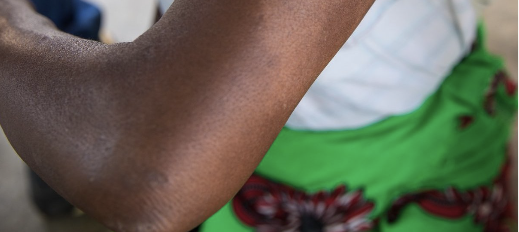The world’s first fast, field-friendly test for leprosy is ready

In her own words, ‘Transmission can be stopped with the help of this test by diagnosing leprosy early.'
This test is a multiplex PCR (mPCR) based TrueNat test, which is a chip based, battery-operated, portable real-time micro-PCR platform and can be used as a field-friendly diagnostic test. It is quick and adaptable enough to work in even the most remote locations.
In this article, we talk to Dr Itu about this exciting new development in the field of leprosy.
Tim Burton from TLM International: Why is a test like this so important for leprosy?
Dr Itu Singh: We currently have very limited options for diagnosing leprosy. The current process of diagnosing through a lab takes between seven and ten days, even in a setting like India, which has more leprosy resources and knowledge than many other countries.
With such a long, drawn-out process, we risk losing any patients whose location is less fixed and failing to get them onto treatment, especially patients in remote locations. Too many people fall through the gaps of those ten days. Even if we manage to get them onto treatment, they may continue to be infectious over With such a long, drawn-out process, we risk losing any patients whose location is less fixed and failing to get them onto treatment, especially patients in remote locations. Too many people fall through the gaps of those ten days. Even if we manage to get them onto treatment, they may continue to be infectious over those seven to ten days. The current test also limits us in other ways. For example, there are two key types of leprosy: a PB case and an MB case. The PB cases have a small amount of bacteria in their bodies and the MB cases have a large amount of bacteria. When we do the current lab test, there is not enough bacteria in our samples for us to be able to see bacteria under the microscope. Because of this, PB cases must be diagnosed clinically; a clinician must recognise the cardinal signs of leprosy and diagnose a person that way.
Which brings us to another challenge: just because a person does not yet have symptoms of leprosy is not the same as saying a person does not have leprosy. They may be early in the incubation period and not yet have any symptoms. In these situations, we are not able to diagnose people and we must wait until symptoms appear. Meanwhile, they continue transmitting the disease.
Or it is possible that a person carries the bacteria, is spreading the bacteria, but will never develop symptoms because they have a strong immune system. All over the world, asymptomatic individuals are spreading leprosy without realising it.
With all of these challenges, you can see that we are fighting against the tide when we try to interrupt leprosy transmission. We have more tools than ever before, but with these challenges, the tide is still pushing us back.

Takeaway One:
Our current diagnostic test is slow, it cannot pick up PB cases or asymptomatic cases, and is only accessible through labs. We are still very reliant on clinical diagnoses and this is holding back our efforts to interrupt leprosy transmission.
Tim: How does your new test solve this problem?
Dr Itu: This test is fast and can work in any context, whether in a hospital or the most low-resource, rural area. Currently we are limited in the number of people we can test for leprosy and we rely a lot on clinicians diagnosing a person when they recognise symptoms. With leprosy expertise falling across the world, that is a risky position for us to be in.
With this test, we can flood the market. Suddenly it will be possible to test millions of people quickly and easily. Any close contacts of an index case can be tested and any people in high-endemic areas can be tested.
Research tells us that there are millions of missing cases of leprosy. These are people who are hard to find and diagnose. With this test, we will find them and we will diagnose them.
We currently use post-exposure prophylaxis (PEP) as a method of preventing leprosy in close contacts of index cases. This is an exciting development in our efforts to eliminate transmission, however it is undoubtedly true that some of those contacts of index cases need more than a single dose of Rifampicin (the current PEP regimen). Some of those individuals need a full course of MDT (Multi-Drug Therapy – the cure for leprosy). With this tool, we will know who those people are.
Because there is so much we don’t yet understand about leprosy, our current approach to transmission is a bit like driving in the dark on familiar roads. We know the roads well enough to find most of the turns, but there is a lot you can miss when you are driving in the dark. This diagnostic test is the light on the road; all of a sudden, we can see where we are going and we won’t miss any turns.
Takeaway Two:
This fast, adaptable test can be used quickly and easily across the world, allowing us to test millions more people and find those people who go undiagnosed so we can get them onto the treatment they need.
Tim: Tell us more about this test. How does it work and why can it be adapted to even low-resource settings?
Dr Itu: We have been working on this test since 2014. Over the last decade, we have been slowly perfecting it, making it more sensitive so that it can pick up leprosy bacteria accurately. We have done this by increasing the number of genes that the test detects; it detects three different genes, which is why we call it mPCR – a multiplex PCR test.
For the test, we use a portable real-time PCR machine that is battery operated. You could use it anywhere. It is a machine that can test for lots of other diseases, so many primary healthcare workers are already using them. To buy a new one would cost around $10k.
The process is quite simple and does not require clinicians to be experts in leprosy. The clinician will take a slit skin sample from the ear lobes or a skin patch of a suspected case or through a nasal swab of a close contact. They mix this sample with a buffer and place the sample into a cartridge.
The cartridge goes into a portable and battery-operated DNA extraction device for 20 minutes, from which they will receive a purified DNA sample. This sample is placed on a small chip and placed into the PCR machine. The PCR machine is pre-programmed to test for leprosy and will provide the clinician with detailed results within one hour after sample collection, stating whether a person has MB or PB leprosy. These results can then be sent to a phone or a laptop.
We have tested this approach extensively over the last decade and we now know that the device is 100 percent accurate for MB cases of leprosy and 88 percent accurate for PB cases. This test works and it is going to help us end leprosy transmission.
We have tested this approach extensively over the last decade and we now know that the device is 100 percent accurate for MB cases of leprosy and 88 percent accurate for PB cases. This test works and it is going to help us end leprosy transmission.
Takeaway Three:
The mPCR test takes less than an hour. Each machine costs around $10k and the test has been shown to be highly effective, even with PB leprosy.
Tim: This is a really exciting development in our field. What does the future look like for this test?
Dr Itu: We have just received a manufacturing approval from the Indian government, which is a big step towards getting this rolled out across India. That national-level roll out will be the first step for this test. As India accounts for two thirds of the world’s leprosy cases, it is the perfect country to have the first roll out of this test.
Another crucial step for us will be to get WHO approval for the test. They have already approved the same test for tuberculosis and we are hopeful that in time they will give the necessary approvals for this test, as well.
As we roll out this test across other countries, we will see that each context faces different challenges. The roll out will not be a straight line, but we will learn as we go along, especially by working with national TB teams, who are already using a test like this. We will also need to secure the supply chains for the materials that this test requires.
As we roll the test out, we will suddenly have more information about leprosy than we have ever had before. We will need to learn from that information and determine what kinds of treatments to give patients. Do they need PEP or MDT? Maybe another approach will emerge to treat patients who we currently do not even know to treat.
As we roll the test out, we will suddenly have more information about leprosy than we have ever had before. We will need to learn from that information and determine what kinds of treatments to give patients. Do they need PEP or MDT? Maybe another approach will emerge to treat patients who we currently do not even know to treat.
The crucial thing will be for governments to see the value in the tool. Between this tool and the efficacy of PEP, we have a really convincing case to take to governments; with the right investment of resources into their health systems, they will be able to eliminate leprosy in their country.

Takeaway Four:
Our case for investment into leprosy is stronger thanks to this test and it opens up opportunities for us to learn more about leprosy than we have ever known before.
The next steps
01
Roll out in India
Ensure teams across India become familiar with this test and are trained to use it.
02
WHO approval
Although WHO approval may take some time, they have approved a similar tool for TB.
03
Global rollout
Discover how to implement this test in new and different country contexts.
04
Continued research
This test will provide us with more data on leprosy which researchers can study.
05
Zero leprosy
The ultimate hope for this test is that it will enable us to end the transmission of leprosy.
We believe this new test will play a central role in eliminating leprosy.